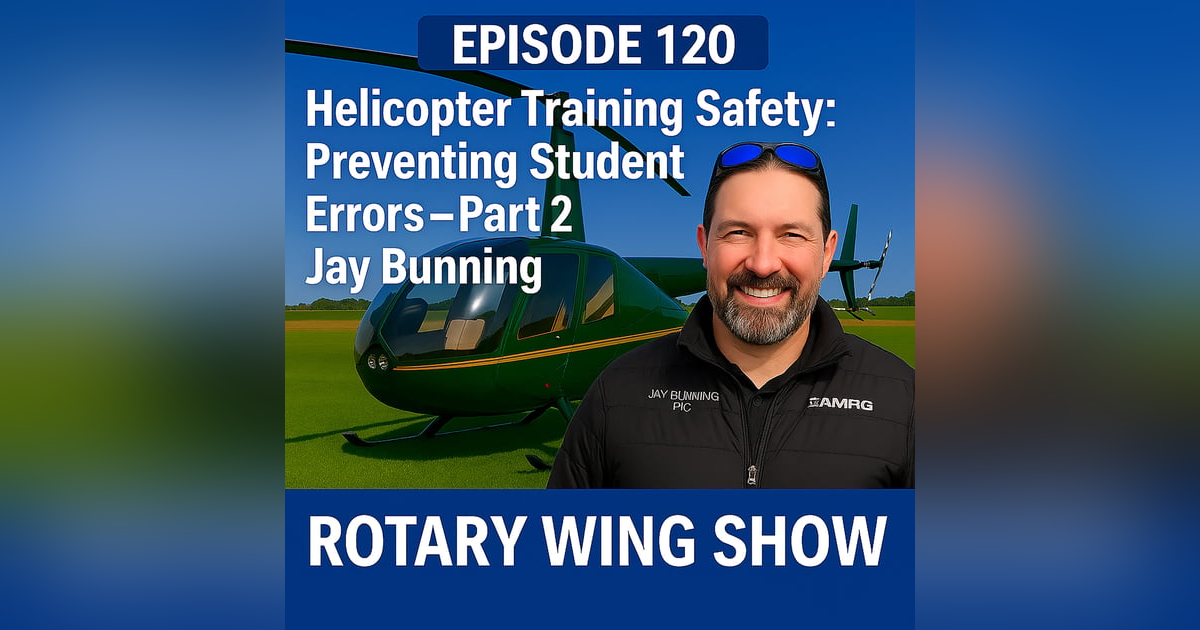Helicopter Training Safety: Preventing Student Errors with Jay Bunning – Part 2

Max talks with Jay Bunning, CFI and creator of helicoptertrainingvideos.com, for Part 2 of their series on Helicopter Training Safety: Preventing Student Errors. Following up from Part 1, Jay brings real-world accident examples and practical strategies for instructors to manage common mistakes during training flights.
We need your help to improve the show! To do that, we need you to take our Rotary Wing Show Listener Survey. We have a new host and the show may change in some ways, and to guide those changes we need your feedback. So please take a few minutes and fill in the survey now.
Also, have you ever have you ever thought that you might like to have Internet service available when you’re flying in either a helicopter or a GA aircraft? To learn everything you need to know about how to set up and use Starlink in a small aircraft listen to episode 400 of the Aviation News Talk podcast. And click here to find the bits and pieces you need to make Starlink work.
Quick Stops / Rapid Decelerations
Jay begins with rapid deceleration or quick stop maneuvers, which require simultaneous control of cyclic, collective, and pedals. He explains why instructors must guard both pedals closely, since students often apply the wrong pedal or fail to add left pedal when raising collective. Improper collective inputs can also create conditions for vortex ring state (VRS), overspeed, or altitude loss. Jay notes the importance of sequencing training—avoiding quick stops immediately after autorotations to prevent negative transfer, since students sometimes confuse the two and roll off throttle. He also highlights an R44 accident where a CFI invented a non-standard rapid decel procedure that ended in rollover—reinforcing why instructors must stick to manufacturer guidance
Vortex Ring State (VRS)
The conversation moves to vortex ring state, also known as “settling with power.” Jay explains both the traditional recovery—lowering collective and pushing forward cyclic to gain airspeed—and the Vard (lateral) recovery, which uses collective, left pedal, and right cyclic to slide out of the recirculation. While the Vard technique can recover faster, Jay cautions against prolonged drifting, over-banking, or excessive collective input, which can cause yaw or RPM decay. He stresses training students to recognize the first indications of VRS—unusual vibrations, buffeting, or an increasing descent rate—and recover immediately. Riding a helicopter deep into VRS for demonstration purposes has caused accidents, including the in-flight breakup of an AS350 during training. Both Airbus and Robinson have issued safety advisories warning against prolonged or aggressive inputs during VRS demonstrations
Hover Autos
Finally, Jay addresses hover autorotations, calling them the most complex maneuver for instructors to teach. The challenge lies in managing throttle, pedals, cyclic, and collective inputs—all in under two seconds, especially in the R22. Instructors must guard against incorrect pedal use, premature collective pulls that balloon the aircraft, or students rolling throttle the wrong way. Jay explains how training should progress gradually, starting with throttle roll-offs on the ground, then introducing forward taxi hover autos before moving to stationary hovers. He also cites an R22 dynamic rollover accident caused by gusty winds and improper cyclic control, reinforcing the need to practice only in stable conditions.
Key Takeaways
Throughout the episode, Jay stresses several safety principles:
- Sequence maneuvers wisely to avoid negative transfer.
- Train students to recognize first symptoms and recover early.
- Stick to proven, manufacturer-recommended procedures.
- Instructors must “ghost” maneuvers—mentally flying along and guarding controls.
- Simulators can safely replicate scenarios like VRS close to the ground.
This second part of Max’s conversation with Jay offers valuable insights for CFIs and students alike. By anticipating common errors and adopting safer training practices, instructors can reduce risk and help prevent accidents that still appear far too often in helicopter operations




